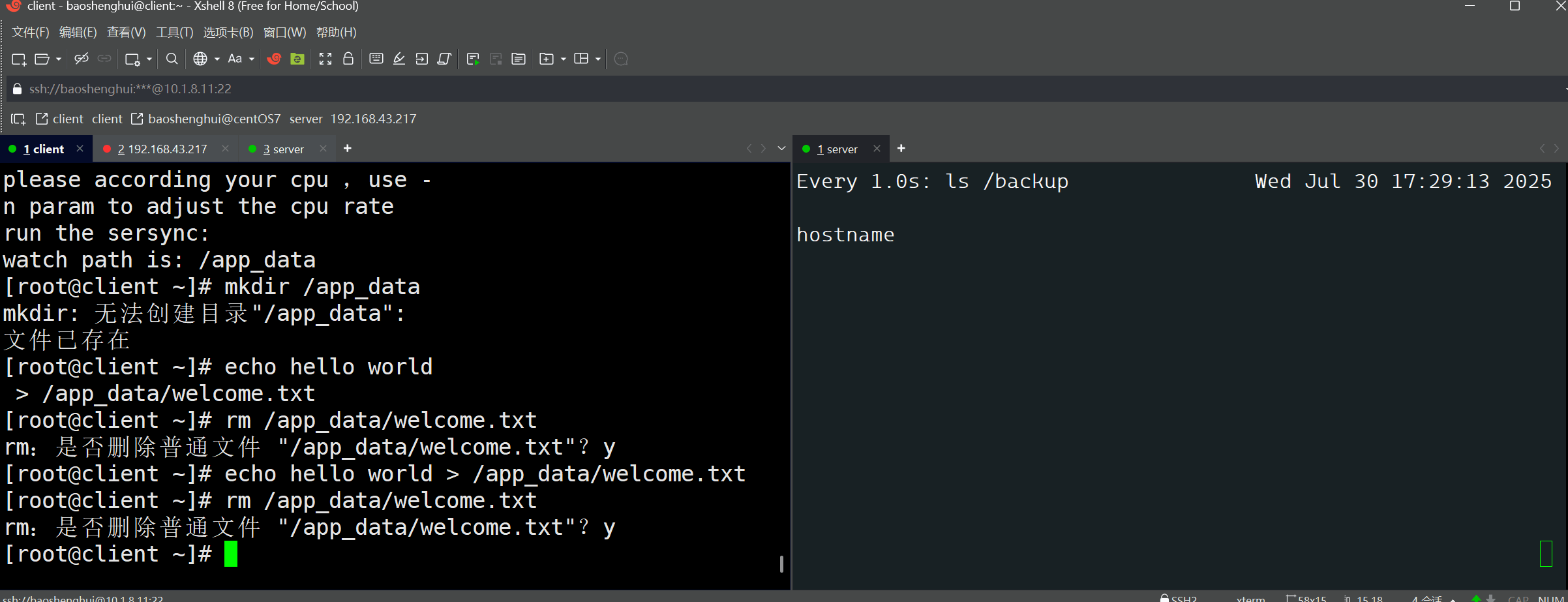项目实战:Rsync + Sersync 实现文件实时同步
客户端中数据发生变化,同步到server端(备份服务器)。
Rsync:负责数据同步,部署在server端。
Sersync:负责监控数据目录变化,并调用rsync进行同步,*部署在client端。
部署 Rsync 服务
安装软件包
bash
[root@server ~]# yum install -y rsync-daemon配置 rsync
本次实验使用验证用户同步。
bash
#web服务器的数据变化,同步给 backup
# 准备同步目录,该目录任何用户都可以读写。
[root@server ~]# mkdir -m 777 /backup
# 配置rsync,不验证用户,直接同步
[root@server ~]# vim /etc/rsyncd.conf
......
# 添加如下配置
[backup]
# 描述信息
comment = backup
# 备份路径
path = /backup
# 设置可写
read only = no
# 指定用户名
auth users = rsync
# 指定用户密码文件
secrets file = /etc/rsyncd.secrets
# 创建用户凭据文件
[root@server ~]# echo 'rsync:123' > /etc/rsyncd.secrets
[root@server ~]# chmod 400 /etc/rsyncd.secrets
# 启用并启动rsyncd服务
[root@server ~]# systemctl enable rsyncd --now
# 配置防火墙
[root@server ~]# firewall-cmd --add-service=rsyncd
[root@server ~]# firewall-cmd --add-service=rsyncd --permanent更多 rsyncd.conf 配置参考 rsyncd.conf(5)。
客户端配置和测试
bash
# 准备密码文件
[root@client ~]# echo 123 > rsyncd.secrets
#只读权限(仅编辑用户拥有)
[root@client ~]# chmod 400 rsyncd.secrets
# 传输测试
#关闭 SELinux
[root@server baoshenghui]# setenforce 0
[root@client ~]# rsync -av /etc/hostname rsync@server::backup
Password:
sending incremental file list
hostname
sent 114 bytes received 35 bytes 59.60 bytes/sec
total size is 20 speedup is 0.13
# 验证结果
[root@server ~]# ls /backup/
hostname部署 Sersync 服务
Sersync 服务介绍
sersync 使用c++编写,类似于inotify,同样用于监控,但它克服了inotify的缺点。
inotify 最大的不足是会产生重复事件,或者同一个目录下多个文件的操作会产生多个事件,例如,当监控目录中有5个文件时,删除目录时会产生6个监控事件,从而导致重复调用rsync命令。比如:vim文件时,inotify会监控到临时文件的事件,但这些事件相对于rsync来说是不应该被监控的。
sersync 优点:
- sersync 同步效率更高,它会对linux系统文件系统产生的临时文件和重复的文件操作进行过滤,节省了运行时耗和网络资源。
- sersync配置很简单,其中提供了静态编译好的二进制文件和xml配置文件,直接使用即可。
- sersync使用多线程进行同步,尤其在同步较大文件时,能够保证多个服务器实时保持同步状态。
- sersync有出错处理机制,通过失败队列对出错的文件重新同步,如果仍旧失败,则按设定时长对同步失败的文件重新同步。
- sersync自带crontab功能,只需在xml配置文件中开启,按要求隔一段时间整体同步一次。
- sersync 可以二次开发。
sersync项目地址:https://code.google.com/archive/p/sersync/
sersync下载地址:https://code.google.com/archive/p/sersync/downloads
安装软件包
bash
# 下载软件
[root@client ~]# wget https://storage.googleapis.com/google-code-archive-downloads/v2/code.google.com/sersync/sersync2.5.4_64bit_binary_stable_final.tar.gz
# 解压文件
[root@client ~]# tar -xf sersync2.5.4_64bit_binary_stable_final.tar.gz
[root@client ~]# ls GNU-Linux-x86/
confxml.xml sersync2文件说明:
- sersync2,是二进制程序。
- confxml.xml,是sersync2程序的配置文件。
配置 Sersync
配置文件说明
bash
[root@client ~]# cat GNU-Linux-x86/confxml.xml
xml
<?xml version="1.0" encoding="ISO-8859-1"?>
<head version="2.5">
<!-- hostip与port是针对插件的保留字段,对于同步功能没有任何作用,保留默认即可。 -->
<host hostip="localhost" port="8008"></host>
<!-- 是否开启debug模式 -->
<debug start="false"/>
<!-- 如果是xfs文件系统,则需要设置为true才能同步,rehat/REEL/CentOS/Fedora新版本默认都是xfs文件系统,可使用df -Th命令查看 -->
<fileSystem xfs="true"/>
<!-- 过滤器,设置为true则会对里面的exclude对应的正则匹配到的文件进行过滤,即不同步 -->
<filter start="true">
<!-- <exclude expression="(.*)\.svn"></exclude> -->
<!-- <exclude expression="(.*)\.gz"></exclude> -->
<!-- <exclude expression="^info/*"></exclude> -->
<!-- <exclude expression="^static/*"></exclude> -->
<exclude expression="^cache/*"></exclude>
</filter>
<!-- inotify是linux的内核功能,这里用于设置创建/删除/修改/移动文件时,是否视为文件改变(进而进行同步) -->
<inotify>
<!-- 删除一个文件是否视为文件改变(很明显我们要设置为true) -->
<delete start="false"/>
<!-- 创建一个文件夹是否视为文件改变(很明显我们要设置为true) -->
<createFolder start="true"/>
<!-- 创建一个文件是否触发文件改变事件(这里要设置false,因为创建一个文件除了有createFile事件还会有closeWrite事件,我们只要把closeWrite事件设置为true即可监控到创建 一个文件) -->
<createFile start="false"/>
<!-- 创建文件或修改文件后再关闭会触发该事件,比如vim打开一个文件,修改后用(:wq)保存,则会触发该事件,当然创建新文件一样会触发 -->
<closeWrite start="true"/>
<!-- 从别的地方移到被监控目录是否视为文件改变,毫无疑问要设置为true -->
<moveFrom start="true"/>
<!-- 被监控目录中的某个文件被移动到其他地方算不算文件改变?毫无疑问要设置为true -->
<moveTo start="true"/>
<!-- 文件属性改变了,是否视为文件改变?这个我们可以认为文件没有改,所以设置false -->
<attrib start="false"/>
<!-- 文件内容被修改了是否视为文件改变?感觉文件改变肯定要设置为true,但其实不用,因为这个改变有可能是vim(:w)保存,还没有关闭文件,所以保存的时候没必要同步,而关闭的时候会触发closeWrite,所以修改的文件也是通过closeWrite来同步的 -->
<modify start="false"/>
</inotify>
<!-- servsync的模块 -->
<sersync>
<!-- 指定要监控(即同步)的本地目录 -->
<localpath watch="/data">
<!-- ip指定同步到远程的哪个服务器,name填写远程服务器中rsync配置文件中的自定义模块名称(即中括号括起来的那个名称) -->
<remote ip="10.1.8.10" name="laoma"/>
<!-- 如果你要同步到多台服务器,继续填写即可,每个服务器一个remote标签 -->
<!--<remote ip="192.168.8.40" name="tongbu"/>-->
</localpath>
<!-- rsync模块配置 -->
<rsync>
<!-- 公共参数,即我们手动执行rsync的时候要带的选项就填在这里,servsync会自动组装 -->
<commonParams params="-azP"/>
<!-- 密码文件及指定用户名(用户名就是rsync服务器端配置文件中的"auth user =" 指定的用户名) -->
<auth start="true" users="rsync" passwordfile="/etc/rsyncd.secrets"/>
<!-- 如果你rsync服务器不是默认端口873,那么就要在这里指定具体的端口,当然是默认的你也可以指定一下 -->
<userDefinedPort start="false" port="873"/>
<!-- rsync超时时间 -->
<timeout start="false" time="100"/><!-- timeout=100 -->
<!-- 是否使用ssh方式传输 -->
<ssh start="false"/>
</rsync>
<!-- 对于失败的传输,会进行重新传送,再次失败就会写入rsync_fail_log,然后每隔一段时间(timeToExecute进行设置,单位sec)执行该脚本再次重新传送,然后清空该脚本。可以 通过path来设置日志路径。 -->
<failLog path="/tmp/rsync_fail_log.sh" timeToExecute="60"/><!--default every 60mins execute once-->
<!-- 定期整体同步功能,schedule表示crontab执行间隔,单位是min -->
<crontab start="false" schedule="600"><!--600mins-->
<!-- 同步过滤器,要开启请把start设置为true,用于 整体同步时,排除一些文件或目录,比如缓存目录可以不需要同步 -->
<crontabfilter start="false">
<exclude expression="*.php"></exclude>
<exclude expression="info/*"></exclude>
</crontabfilter>
</crontab>
<!-- 同步完成后,执行一个插件,name表示执行哪些插件,而这个插件必须在后边用plugin标签定义 -->
<plugin start="false" name="command"/>
</sersync>
<!-- 定义一个command插件(command插件类型的一种,另外的类型有socket,refreshCDN,http(目前由于兼容性问题,http插件暂时不能用)) -->
<plugin name="command">
<!-- command插件其实就是".sh"结尾的shell脚本文件,prefix和subffix用于拼成一条执行shell命令的命令 -->
<param prefix="/bin/sh" suffix="" ignoreError="true"/> <!--prefix /data/wwwroot/mmm.sh suffix-->
<!-- 该脚本做操作时要过滤的文件正则 -->
<filter start="false">
<include expression="(.*)\.php"/>
<include expression="(.*)\.sh"/>
</filter>
</plugin>
<!-- 定义一个socket插件,注意插件定义了但没有调用的话,是不会被执行的 -->
<plugin name="socket">
<localpath watch="/data">
<deshost ip="192.168.138.20" port="8009"/>
</localpath>
</plugin>
<!-- 定义一个refreshCDN插件,主要用于同步数据到cdn -->
<plugin name="refreshCDN">
<localpath watch="/data0/htdocs/cms.xoyo.com/site/">
<cdninfo domainname="ccms.chinacache.com" port="80" username="xxxx" passwd="xxxx"/>
<sendurl base="http://pic.xoyo.com/cms"/>
<regexurl regex="false" match="cms.xoyo.com/site([/a-zA-Z0-9]*).xoyo.com/images"/>
</localpath>
</plugin>
</head>配置文件示例
本次实验使用的示例文件。
bash
[root@client ~]# vim confxml.xml
xml
<?xml version="1.0" encoding="ISO-8859-1"?>
<head version="2.5">
<host hostip="localhost" port="8008"></host>
<debug start="false"/>
<fileSystem xfs="true"/>
<filter start="true">
<exclude expression="^cache/*"></exclude>
</filter>
<inotify>
<delete start="true"/>
<createFolder start="true"/>
<createFile start="false"/>
<closeWrite start="true"/>
<moveFrom start="true"/>
<moveTo start="true"/>
<attrib start="false"/>
<modify start="false"/>
</inotify>
<sersync>
<localpath watch="/app_data">
<remote ip="10.1.8.10" name="backup"/>
</localpath>
<rsync>
<commonParams params="-azP"/>
<auth start="true" users="rsync" passwordfile="/root/rsyncd.secrets"/>
<userDefinedPort start="false" port="873"/>
<timeout start="false" time="100"/>
<ssh start="false"/>
</rsync>
<failLog path="/tmp/rsync_fail_log.sh" timeToExecute="60"/>
<crontab start="false" schedule="600"><!--600mins-->
<crontabfilter start="false">
<exclude expression="*.php"></exclude>
<exclude expression="info/*"></exclude>
</crontabfilter>
</crontab>
<plugin start="false" name="command"/>
</sersync>
<plugin name="command">
<param prefix="/bin/sh" suffix="" ignoreError="true"/>
<filter start="false">
<include expression="(.*)\.php"/>
<include expression="(.*)\.sh"/>
</filter>
</plugin>
</head>运行 Sersync
bash
# 准备同步目录
[root@client ~]# mkdir /app_data
# 复制程序到$PATH中
[root@client ~]# cp GNU-Linux-x86/sersync2 /usr/local/bin/
[root@client ~]# sersync2 -h
set the system param
execute:echo 50000000 > /proc/sys/fs/inotify/max_user_watches
execute:echo 327679 > /proc/sys/fs/inotify/max_queued_events
parse the command param
_______________________________________________________
参数-d:启用守护进程模式
参数-r:在监控前,将监控目录与远程主机用rsync命令推送一遍
参数-n: 指定开启守护线程的数量,默认为10个
参数-o:指定配置文件,默认使用confxml.xml文件
参数-m:单独启用其他模块,使用 -m refreshCDN 开启刷新CDN模块
参数-m:单独启用其他模块,使用 -m socket 开启socket模块
参数-m:单独启用其他模块,使用 -m http 开启http模块
不加-m参数,则默认执行同步程序________________________________________________________________
# 运行 Sersync
[root@client ~]# sersync2 -o confxml.xml -d
set the system param
execute:echo 50000000 > /proc/sys/fs/inotify/max_user_watches
execute:echo 327679 > /proc/sys/fs/inotify/max_queued_events
parse the command param
option: -o config xml name: confxml.xml
option: -d run as a daemon
daemon thread num: 10
parse xml config file
host ip : localhost host port: 8008
now the filter work ,if you set the crontab,you have to set crontab filter
WARNING XFS FILE SYSTEM WORK
daemon start,sersync run behind the console
use rsync password-file :
user is rsync
passwordfile is /root/rsyncd.secrets
config xml parse success
please set /etc/rsyncd.conf max connections=0 Manually
sersync working thread 12 = 1(primary thread) + 1(fail retry thread) + 10(daemon sub threads)
Max threads numbers is: 22 = 12(Thread pool nums) + 10(Sub threads)
please according your cpu ,use -n param to adjust the cpu rate
run the sersync:
watch path is: /app_data测试
bash
# server 端监控目录 /backup
[root@server ~]# watch -n 1 ls /backup
# 客户端创建文件和目录
[root@client ~]# echo hello world > /app_data/welcome.txt
[root@client ~]# mkdir /app_data/dbdata
# 客户端删除文件
[root@client ~]# rm -fr /app_data/*监控运行效果如下:(创建welcome.txt-->删除welcome.txt)

配置 systemd 管理 Sersync
bash
[root@client ~]# cp confxml.xml /etc/sersyncd.conf
[root@client ~]# vim /etc/systemd/system/sersyncd.service
[Unit]
Description=SerSync server daemon
[Service]
Type=forking
ExecStart=/usr/local/bin/sersync2 -o /etc/sersyncd.conf -d
[Install]
WantedBy=multi-user.target
[root@client ~]# systemctl daemon-reload
[root@client ~]# systemctl enable sersyncd.serviceoot@client ~]# cp confxml.xml /etc/sersyncd.conf
root@client \~\]# vim /etc/systemd/system/sersyncd.service \[Unit
Description=SerSync server daemon
Service
Type=forking
ExecStart=/usr/local/bin/sersync2 -o /etc/sersyncd.conf -d
Install
WantedBy=multi-user.target
root@client \~\]# systemctl daemon-reload \[root@client \~\]# systemctl enable sersyncd.service ``` ```